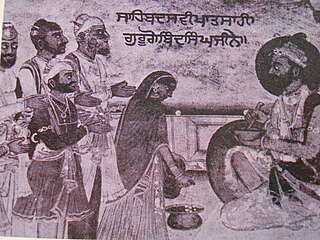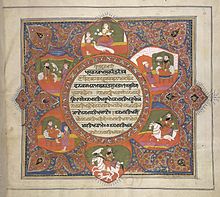
The Dasam Granth is a collection of various poetic compositions attributed to Guru Gobind Singh. The text enjoyed an equal status with the Adi Granth, or Guru Granth Sahib, in the eighteenth and nineteenth centuries and were installed side by side on the same platform. The Dasam Granth lost favor during the colonial period when reformist Singh Sabha Movement scholars couldn't contextualize the reworkings of Puranic stories or the vast collection of 'Tales of Deceit' Sri Charitropakhyan.

The Sarbloh Granth or Sarabloh Granth, also called Manglacharan Puran or Sri Manglacharan Ji, is a voluminous scripture, composed of more than 6,500 poetic stanzas. It is traditionally attributed as being the work of Guru Gobind Singh, the tenth Sikh guru. Scholars, on the other hand, attribute the work to after the Guru's death, being authored by an unknown poet. The work is mostly revered by the Nihang sect.

The Bachittar Natak or Bachitar Natak is partly an autobiography of Guru Gobind Singh. The appellation Bachitar Natak is sometimes confusingly only applied around the Dasam Granth. The Bachitar Natak Granth, not to be confused with the Bachittar Natak composition, contains a large corpus of the Dasam Granth canon.
Sahib Singh was one of the Panj Pyare. He was formerly known as Sahib Chand and was born into the Nai caste before being baptized into the Khalsa tradition.

The principal Sikh scripture is the Adi Granth, more commonly called the Guru Granth Sahib. The second most important scripture of the Sikhs is the Dasam Granth. Both of these consist of text which was written or authorised by the Sikh Gurus.

Mata Sahib Devan, also known as Mata Sahib Kaur and Mata Sahib Devi, was a wife of Guru Gobind Singh.

Mātā Jīto, or Ajeet Kaur, was a wife of Guru Gobind Singh.

Guru Maneyo Granth refers to the historic statement of the 10th Sikh Guru, Guru Gobind Singh (1666–1708) shortly before his demise on affirming the sacred scripture Adi Granth as his successor, thereby terminating the line of human Gurus. Installed as the Guru Granth Sahib, it is now the central holy scripture of Sikhism, and the eternal living Guru of all Sikhs. It is central to Sikh worship as it is said to imbibe the one light of the creator manifested in the Ten Sikh Gurus‐one spirit in ten forms.
Bhai Mansukh was a devout Sikh and a trader from Lahore region and was disciple of the Guru Nanak. He embraced Sikh faith in company of Bhai Bhagirath.

Hikaaitaan or Hikāyatān is a title given to the semi-legendary set of 11 tales, composed in the Gurmukhi/Persian vernacular, whose authorship is traditionally attributed to Guru Gobind Singh. It is the last composition of the second scripture of Sikhs, Dasam Granth, and some believe it to be appended to Zafarnamah—the letter to Mughal emperor Aurangzeb.

Khalsa Mahima is the name of two compositions that praise the Khalsa in poetic form, composed by Guru Gobind Singh, each present in Dasam Granth and Sarbloh Granth.

Sri Charitropakhyan or Pakhyan Charitar and also Tria Charitra is a huge composition of short stories, with the purpose of learning from others' mistakes to acquire more refined judgement in all fields, present in Dasam Granth, which is generally and traditionally ascribed to Guru Gobind Singh. The composition contains 405/404 tales or episodes of wiles of men and women, containing many historical, mythological and philosophical aspects, having 7558 verses. This composition ends at Chopai which is one of the Nitnem banis. The term Charitropakhyan is derived from two words, Charitar means characteristics/function of character and Pakhyan means already told. There are two types of Charitars, Purakh Charitar and Tria Chariter.

Chaubis Avtar is a composition in Dasam Granth containing history of 24 incarnations (avatars) of Vishnu.

Binod Singh, a Trehan Khatri and a descendant of Guru Angad, was an army man and disciple of Guru Gobind Singh and was among few Sikhs who accompanied him to Nanded in 1706. In Budha Dal Chronicles, Guru Gobind Singh made Baba Binod Singh the head of the Khalsa.
This is a list of works by Indian Punjabi-language writer Bhai Vir Singh (1872–1957). This list includes his poetry, novels, translations, plays, and non-fiction.

Ramkali Sadh is a composition present in Guru Granth Sahib on ang 923/924, composed by Baba Sundar, in Ramkali Raga. The composition has 6 stanzas. Sadh literally means Call (ਸੱਦਾ). This narration tells Sikh attitude towards physical death of a Gurmukh. It also narrates events of succession of Gur Ram Das over Gur Amar Das.
Padarath is used in Sikhism for a "step of spiritual Enlightenment." In the Guru Granth Sahib, the term padarath is used for temporal, as well as spiritual, attainments.

Bhattan de Savaiye, also known as Bhatt Bani, is a name given to 123 Savaiyas composed by various Bhatts, which are present in Guru Granth Sahib, scripture of Sikhs. According to various scholars, these Savaiyas are eulogies of first five Gurus of Sikhism.
Jaswant Singh Khoji was the founder of Braham Bunga Trust and Naam Simran congregation camps at Dodra.

Baba Biram Das was born at Lakhnaur Sahib and is considered to be one of the greatest Udasi sants. His birth date is mentioned as 1636. However, the exact date of birth is not confirmed. His actual name was Ratan Das. He was son of Mata Gujri's paternal uncle Baba Biram Das had a very strong bond with Mata Gujri since they had spent their childhood together with each other. He was also the maternal uncle of Guru Gobind Singh. From childhood, Baba Biram Das was immensely engrossed in his devotion towards God.





























